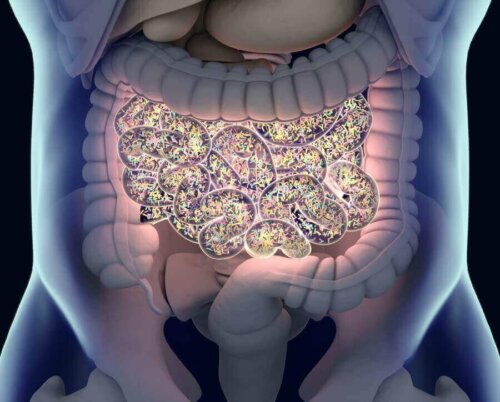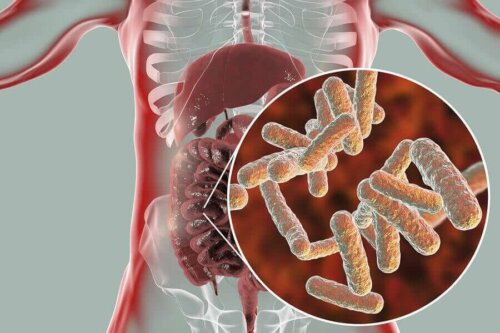What Is Normal Microbiota?


Written and verified by the biologist Samuel Antonio Sánchez Amador
Bacteria are microorganisms that, despite their small size, play an essential role in the functioning of our world. Scientists estimate that they represent 50% of the total biomass on the planet. Human beings also show indispensable relationships with them through their normal microbiota.
In this article, we’ll show you what the normal microbiota of your body is, and what it’s made of, also called the microbiome.
What is the normal microbiota?
The normal microbiota or microbiome is defined as the set of microorganisms that are commonly found in our body in healthy individuals, distributed in different parts of the body.
This interaction is a symbiotic relationship between the host and the bacteria, since both parties benefit from the relationship. Some of the benefits are the following:
- Bacteria aid in the digestion of food that humans can’t assimilate in any other way.
- They produce vitamins and compounds that you can’t get from other sources.
- They protect your body from the colonization of other microorganisms that may be pathogenic, something known as microbial antagonism.
The normal microbiota is essential in the proper functioning of our physiological systems. Sources like the National Autonomous University of Mexico estimate that humans have around 100 billion microorganisms in their bodies. This shows that we can’t conceive of our existence as it is today without the microbiome.

Learn more: Microbiota-Accessible Carbohydrates (MACs)
Human microbiota categories
The term flora is used in an erroneous way if we analyze the use of the word, since it has been established that bacteria are not related in any way to vegetables. For this reason, it’s better to refer to the different bacterial populations grouped by their functions as microbial ecosystems.
The set of all these populations give rise to the normal microbiota, which we divide into two categories:
- Autochthonous microbiota: these are the microorganisms that live in our body for an indefinite or prolonged time. They participate in quantifiable physiological processes and have evolved together with our species thanks to the fact that they have adapted to the environment we offer them.
- Allochthonous microbiota: these microorganisms appear in any habitat and can appear in our bodies accidentally or temporarily. They don’t participate in physiological processes, since their relationship with human beings is based on casual encounters.
This general term can also be qualified according to the residence time of the organisms:
- Latent microbiota: this is the set of organisms that the host presents throughout its life cycle. In this case, the host is us. Populations don’t usually fluctuate significantly, and the symbiosis ratio is complete.
- Transient microbiota: this is the type that has continuous fluctuations in its population and is usually not essential for the survival of the host. Factors such as the time of year, age, or drugs can cause it to change.
Therefore, the bacteria in our intestinal tract would be an example of a native and latent microbiota. They’re necessary for the proper functioning of the digestive system and remain with us throughout life.
Learn more: The Differences Between Viruses and Bacteria
What is the normal microbiota made of?

In a healthy living being, internal tissues such as blood or the brain are free of bacteria. By contrast, the external tissues and those surrounded by mucosa, such as the intestine, skin or pharynx, have abundant symbiotic microorganisms.
Scientists estimate that the gut microbiota contains more than 400 species of bacteria. Going even further: for every human cell they estimate that there are 10 microbes in our body.
Covering all the significant species present in the normal microbiota is practically impossible. For this reason, there are lists of the most common species by body region, according to their common, occasional, rare, or possible pathogen presence. The microbiota has a very clear representation in certain regions such as:
- The skin, dominated by gram-positive bacteria
- The intestine, where the microbiota can weigh around 1.5 kilograms
- The vagina, where the primary genus is Lactobacillus (96% of all microbes in the area)
- The mouth, which has one of the most complex and heterogeneous microbiota in the body
An essential microscopic world
As we’ve been able to see in a general way, the normal microbiota of the human body is infinitely complex. Certain ideas have to be clear to us: some bacteria are essential and always remain in the body, while others are in our body temporarily.
These bacterial populations vary according to the region and the individual, but the set of all of them make up the normal microbiota of the human being.
All cited sources were thoroughly reviewed by our team to ensure their quality, reliability, currency, and validity. The bibliography of this article was considered reliable and of academic or scientific accuracy.
- Microbiota normal, wikipedia. Recogido a 19 de mayo en https://es.wikipedia.org/wiki/Microbiota_normal
- Bolívar, A. K., & Cátedra, D. A. MICROBIOTA ENDÓGENA DEL CUERPO HUMANO.
- López Valencia, L. (2017). Avances en el conocimiento del microbioma humano.
This text is provided for informational purposes only and does not replace consultation with a professional. If in doubt, consult your specialist.








